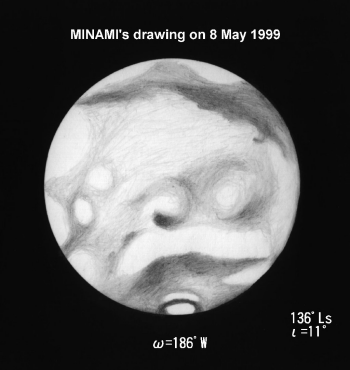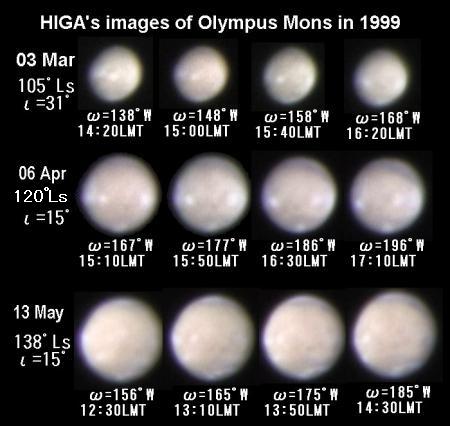98/99 Mars CMO Note (10)
1998/99 Mars CMO Note
- 10 -
from CMO #232
Olympus Mons in the afternoon

It is still interesting to watch diurnally and seasonally the orographic roundish cloud following the summit of Olympus Mons: The cloud appears in a season as a bright small patch just like a white cotton ball. It is known that the cloud is very active and conspicuous in the season from 070°Ls to 130°Ls (cf CMO #134 p1251). Hence the apparitions in 1997 and 1999 cover the very-active period.
In 1997, as reported in #185 (25 Feb 1997) p2002, the scene of the cotton ball attracted the attention of MURAKAMI (Mk), NAKAJIMA (Nj) and the present writer (Mn) at Fukui on 8 & 9 Feb 1997 (076°Ls, the phase angle=25°) before opposition. At LCM=174°W, the Local Martian Time (LMT) of the summit of Olympus Mons was at 16:30 LMT. On 10 Feb 1997 (076°Ls), we enjoyed to trace it from LCM=145°W (14:30 LMT) to LCM=204°W (18:30 LMT) when the cloud was finally on the evening terminator.
As to the trend of Olympus Mons in the evening, a Note in CMO #201 p2243 should be referred.
Earlier observations of Olympus Mons when the apparent diameter was 10.3" were reported in CMO #214 p2442 where ISHADOH (Id)'s drawing on 1 Mar 1999 (104°Ls) at LCM=177°W is shown. The LMT was 17h. Next round in Japan came in mid-April (122°Ls ~ 124°Ls); and Id's and Mk's drawings are shown in CMO #216 p2479: Both were made at 13h LMT.
Thus the apparition in 1999 was suited for watching the later stage of the activity: We pick out here a dozen of HIGA's images of the orographic cloud that show the diurnal change of the cloud in March, April and May 1999. All show the very-active state of the cloud.
To compare the images with those in different seasons, we should not so much refer to the LCM as to the LMT of the cloud. We don't here take into account the reflection angle for sake of simple argument.
 For example, the one on 3 Mar at LCM=158°W should not be compared with the other on 13 May at LCM=156°W. If not we may wrongly judge that the activity in the latter is much weaker than before. Instead, corresponding to the image on 3 Mar at LCM=148°W, we should choose the one on 6 Apr at LCM=167°W and compare them. By the same token, we should compare those on 3 Mar at LCM=158°W/ LCM=168°W with those on 6 Apr at LCM=177°W/ LCM=186°W respectively because of the LMT. We thus safely see that the afternoon activity remained unchanged from 105°Ls to 120°Ls.
For example, the one on 3 Mar at LCM=158°W should not be compared with the other on 13 May at LCM=156°W. If not we may wrongly judge that the activity in the latter is much weaker than before. Instead, corresponding to the image on 3 Mar at LCM=148°W, we should choose the one on 6 Apr at LCM=167°W and compare them. By the same token, we should compare those on 3 Mar at LCM=158°W/ LCM=168°W with those on 6 Apr at LCM=177°W/ LCM=186°W respectively because of the LMT. We thus safely see that the afternoon activity remained unchanged from 105°Ls to 120°Ls.
An example exists which was got between these is given at page 2461 in #215: This is a B image secured by Don PARKER (DPk) on 26 Mar (115°Ls, the phase angle=22°) at LCM=138°W: The cloud is very active at about 13:50 LMT.
The HIGA's image on 13 May (138°Ls) at LCM=185°W should be compared with the one at LCM=138°W on 3 Mar (105°Ls): This tells us that the orographic cloud exists (maybe slightly weakly) even at 138°Ls (at 14:30 LMT).
We are now in a position to note that the first image of HIGA's sequence of 13 May starts from 12:30 LMT (at LCM=156°W) and so the sequence well shows the first half of the afternoon state, while the sequence on 3 Mar the latter half of the afternoon.
To compare the different seasons however it is apparent that the sequences should be much longer including after and before images. HIGA also took the images one round after on 23 June (159°Ls, the phase angle=37°) but just one at LCM=154°W and was not enough.
We finally supplement the above consideration by referring to the images by DPk: The B image taken on 29 Apr (131°Ls) 1999 at LCM=169°W shows well the white orographic cloud of Olympus Mons at 14h LMT, while the image on 4 June (149°Ls) 1999 at LCM=186°W does not well show the brightness of the point at 14h LMT. Apparently the activity began to decrease before 150°Ls, though could not be completely weakened until 180°Ls.
We hope the above consideration will be helpful when we try to analyse any other Martian phenomena within a scope of a longer range.
(Mn)
 For example, the one on 3 Mar at LCM=158°W should not be compared with the other on 13 May at LCM=156°W. If not we may wrongly judge that the activity in the latter is much weaker than before. Instead, corresponding to the image on 3 Mar at LCM=148°W, we should choose the one on 6 Apr at LCM=167°W and compare them. By the same token, we should compare those on 3 Mar at LCM=158°W/ LCM=168°W with those on 6 Apr at LCM=177°W/ LCM=186°W respectively because of the LMT. We thus safely see that the afternoon activity remained unchanged from 105°Ls to 120°Ls.
For example, the one on 3 Mar at LCM=158°W should not be compared with the other on 13 May at LCM=156°W. If not we may wrongly judge that the activity in the latter is much weaker than before. Instead, corresponding to the image on 3 Mar at LCM=148°W, we should choose the one on 6 Apr at LCM=167°W and compare them. By the same token, we should compare those on 3 Mar at LCM=158°W/ LCM=168°W with those on 6 Apr at LCM=177°W/ LCM=186°W respectively because of the LMT. We thus safely see that the afternoon activity remained unchanged from 105°Ls to 120°Ls.